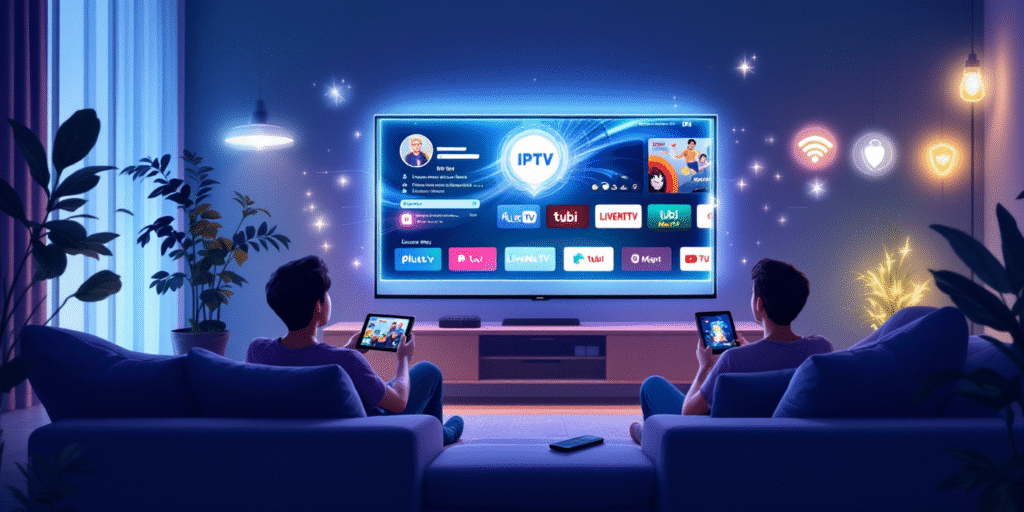How Does IPTV Get Content ?

You can get IPTV content because providers license catalogs and live channel feeds from rights holders, then ingest broadcast streams. They encode/transcode into adaptive bitrate ladders (H.264/HLS, MPEG-DASH), validate GOP/bitrate/audio sync, and secure assets with DRM like Widevine or PlayReady.
Delivery runs on centralized or distributed servers with caching; live may use multicast while VOD uses unicast over CDNs. Your app or set-top box decodes it over your ISP connection. There’s more behind the control planes and resilience choices.
How is IPTV content sourced?
While the delivery stack matters, IPTV starts with lawful content acquisition: providers secure licenses from rights holders to distribute TV shows, films, and live channels under defined terms (format, windows, and territories).
You implement content acquisition through licensing agreements with copyright holders that define catalog scope, rights windows, delivery formats, and reporting obligations. As IPTV providers, you may ingest broadcast feeds from networks to carry live broadcasts with real-time scheduling fidelity.
You expand programming via partnerships with studios, production companies, and aggregators, negotiating exclusive content when it supports differentiation. You must enforce territory restrictions at entitlement and delivery layers, aligning geo-IP, subscriber profiles, and contractual metadata.
How is IPTV content prepared for internet streaming?
Once content is lawfully acquired and normalized, it must be transformed into stream-ready assets through an encoding and transcoding pipeline aligned to IP delivery standards. You ingest raw signals and apply encoding to target digital formats such as H.264 or MPEG‑2, balancing compression for efficient transmission with perceptual quality for high-quality streaming.
You then execute transcoding ladders to generate multiple bitrates and resolutions, optimizing compatibility across devices and variable bandwidth on IP networks.Dedicated servers orchestrate queueing, hardware acceleration, and storage of finalized video streams, ensuring low-latency access for on-demand delivery.
Packaging stages segment assets and apply streaming protocols like HLS or MPEG‑DASH, embedding manifest metadata for adaptive playback. Validation includes bitrate conformance, GOP structure integrity, and audio/video sync, ensuring deterministic, standards-compliant delivery.
Centralized vs Distributed IPTV Delivery — What’s Better?
| Model | How It Works | Pros | Cons |
| Centralized | Few core servers manage all encoding and streaming. | Simple control, easy maintenance. | Bottlenecks, single failure point. |
| Distributed | Regional servers cache and deliver locally. | Low latency, scalable, reliable. | Costly, complex to sync. |
| Hybrid | Mix of central control + edge caching. Multicast for live, unicast for on-demand. | Efficient, flexible delivery. | Complex setup, higher network load. |
Which streaming protocols and DRM systems protect IPTV content?
Even as architectures differ, IPTV delivery relies on standards-based streaming protocols paired with DRM to move and protect video at scale. You’ll see streaming protocols such as HLS, RTMP, and MPEG-DASH orchestrate delivery methods that adapt to network variability.
With adaptive bitrate streaming, segments switch bitrates in real time to sustain video quality under fluctuating throughput. DRM systems like Widevine and PlayReady enforce licenses, encrypt streams, and gate authorized playback, keeping secure content compliant and safeguarding copyrighted content for content creators.
For live channels, IPTV services often use multicast streaming to replicate packets efficiently across the last-mile network, reducing load while maintaining synchronization. VOD commonly rides unicast over HTTP CDNs. Together, protocols and DRM maintain integrity, confidentiality, and availability, ensuring resilient delivery and protected experiences.
Viewer-Side Components: Apps, Set-Top Boxes, and ISPs
When IPTV reaches the viewer, the last mile hinges on three components: the app or set-top box that decodes and renders IP video, the display device, and the ISP network that carries the streams.
You use IPTV apps on Android, iOS, and smart TVs, or dedicated set-top boxes, to translate IP packets into audio/video your display accepts. Set-top boxes often expose interactive features, guide data, and remote control integrations.
Internet Service Providers provision bandwidth and manage transport paths; your link quality governs stability, latency, and high-definition fidelity. For 1080p, target at least 25 Mbps; more is advisable for concurrent streaming.
- Choose standards-compliant apps or set-top boxes.
- Validate Internet Service Providers’ throughput and contention.
- Test content playback, interactive features, and QoS under load.
Frequently Asked Questions
How Does IPTV Actually Work?
You use IPTV via streaming technology over IP, where service providers handle content delivery with video compression and network protocols. You navigate user interfaces, subscribe to subscription models, access live broadcasting and on demand services, respecting content licensing and QoS.
What Is the Source of IPTV?
You source IPTV via media partnerships, content aggregation, and content licenses from broadcast networks, streaming services, and video on demand libraries, plus satellite feeds and cable subscriptions, governed by digital rights, transported via standards-based internet protocols for compliant distribution.
What Are the Disadvantages of Using IPTV?
You face Internet dependency, buffering issues, service outages, and regional restrictions degrading content quality and user experience. Limited channels, device compatibility constraints, variable technical support, and escalating subscription costs complicate multi-device workflows and SLAs, impacting availability, performance baselines, and standards-aligned delivery.
Is IPTV Legal in the United States?
Yes. IPTV legality in the United States depends on IPTV licensing and IPTV compliance. You must choose IPTV providers with licensed IPTV content and a legitimate IPTV subscription. IPTV regulations and IPTV enforcement protect IPTV rights; unlicensed IPTV users risk penalties.